Alright, beloved readers. It’s time we had a talk about all these books with ‘girl’ in the title.
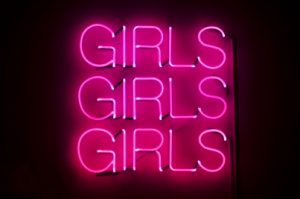
A number of people wiser, sager, and probably more rational than I have weighed in on this topic already, so let’s take a look through them first. Perhaps the most statistically interesting factoid about “girls” in books came from Emily St. John Mandel, best-selling author of the National Book Award finalist Station Eleven.
St. John Mandel and her research assistant used Goodreads to track titles with “girl” in it, and gather data from those results. They whittled down the 2,000 most popular books with “girl” in the title, eliminating children’s and young adult books, eventually getting a list of 810 books. You can read the full break-down of her data in an article published at fivethirthyeight.com, but the two points that most media sites picked up on was that the “girl” in question was rarely “girl” aged. 68% of the time, she was usually a grown-up woman. Secondly, “girl” books written by women had a better chance of surviving the book than “girl” books written by men:
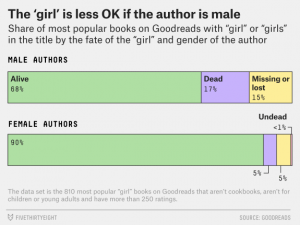
First and foremost, can we talk for a moment about how there were more than 810 books with “girl” in the title for St. John Mandel to use? That is a colossal number–and it seems to be rising. Though this graph is a little dated at this point, you can still see how many novels are have “girls” in their title and in their plots:
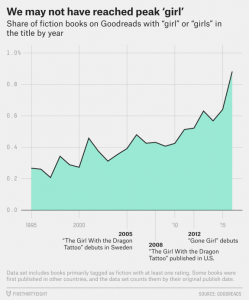
There are reasons for this: first, publishing is a precarious, unpredictable, and downright weird business. If publishers can find a trend that works, they will milk it for every tiny drop they possibly can. So when “girl” books like The Girl With the Dragon Tattoo, Gone Girl, and The Girl on the Train did so colossally well (and their movie adaptations, by and large, succeeded, too), there was a huge push to get more and more books that would attract readers looking for a new fix. There are a lot of thematic parallels in these books–unreliable narrators, women in peril, noirish themes, conspiracies, small town/home town settings, etc–and publishers are banking on the fact that you will finish one “girl” book and head right for the next. That’s why they all look so similar, too! In a piece for The Guardian, Eva Wiseman described them as “embossed covers in shades of storm”. And as each “girl” book succeeds, the need for more grows.
But there’s way more to it than just linguistics and marketing. There’s that 68% of “girls” being grown-up women, and everyone still calling her/them “girls”.
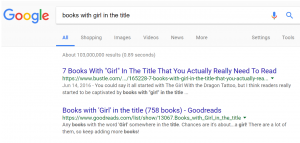 Eva Wiseman sees the trend as subversive, because “the girl is a “girl” not because she’s weak, but because she is on the verge of changing into something else. She’s not simply a victim, or a wife.” Robin Wasserman also argues there is potential in the word: “To be called “just a girl” may be diminishment, but to call yourself “still a girl,” can be empowerment, laying claim to the unencumbered liberties of youth. As Gloria Steinem likes to remind us, women lose power as they age. The persistence of girlhood can be a battle cry.” Emily Roese argues that “When ‘girl’ is not taken to mean naïve or innocent, but instead flexible and susceptible to change, the term can be a highly empowering label that neither whittles the protagonist down to a shell of a woman stripped of motherhood, nor demotes her to a naive youth. Within this terminology, woman’s wisdom and awareness is retained, while girl’s ingenuity and creativity can resurface.”
Eva Wiseman sees the trend as subversive, because “the girl is a “girl” not because she’s weak, but because she is on the verge of changing into something else. She’s not simply a victim, or a wife.” Robin Wasserman also argues there is potential in the word: “To be called “just a girl” may be diminishment, but to call yourself “still a girl,” can be empowerment, laying claim to the unencumbered liberties of youth. As Gloria Steinem likes to remind us, women lose power as they age. The persistence of girlhood can be a battle cry.” Emily Roese argues that “When ‘girl’ is not taken to mean naïve or innocent, but instead flexible and susceptible to change, the term can be a highly empowering label that neither whittles the protagonist down to a shell of a woman stripped of motherhood, nor demotes her to a naive youth. Within this terminology, woman’s wisdom and awareness is retained, while girl’s ingenuity and creativity can resurface.”
I don’t think any of these wise interpretations are necessarily wrong. But I think there is something more to it. But these “girls”, and this is important, are acting independently. Whether it’s in vanishing, or in solving a mystery, or through lying, or through truth-telling. These “girls” are, to whatever extent is possible, controlling their own narrative.
In literature, typically, when “girls” grow up, they are supposed to become “wives”, or “mothers”, or fill a position that is inherently relationship-oriented, but “nurse”….Which also explains the rash of books out there called “The [Insert Profession]’s Daughter“, or “The [Insert Profession]’s Wife“, with the assumption being that the [Professional] discussed in a man. Men are defined by their professions; women are defined by their relationships to men. But these “girls” are not “wives” or “mothers”, whose existence is dependent on their relationship to another. They are independent entities, demanding to be the center of the story that is being told.
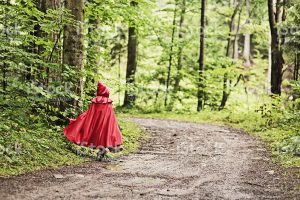 That we are highlighting the actions and roles of women in these stories is also pretty significant. But to keep calling them “girls” traps these characters in a kind of fairytale world where young ladies went where they weren’t supposed to go. The fact that these The “girls” in these titles are very often portrayed as vulnerable, breakable, and, possibly, insane, reinforces that. Or else it uses “girls” in the same way we say “girls’ night” or call things “girly”. It trivializes the power and agency these characters have in their stories.
That we are highlighting the actions and roles of women in these stories is also pretty significant. But to keep calling them “girls” traps these characters in a kind of fairytale world where young ladies went where they weren’t supposed to go. The fact that these The “girls” in these titles are very often portrayed as vulnerable, breakable, and, possibly, insane, reinforces that. Or else it uses “girls” in the same way we say “girls’ night” or call things “girly”. It trivializes the power and agency these characters have in their stories.
I realize that “girl” is quicker to say and potentially easier to remember than “woman”. And I also realize that there are times where “girls” are more appropriate to the story than “woman”–I’m thinking specifically of Emma Cline’s The Girls…But we shouldn’t be afraid of “women”, in books, or in real life…in both fiction and reality, women do lots of things all the time, all by themselves. But by insisting on referring to these characters as “girls”, we’re downplaying a really fascinating literary trend, as well as the characters who made that trend possible.
